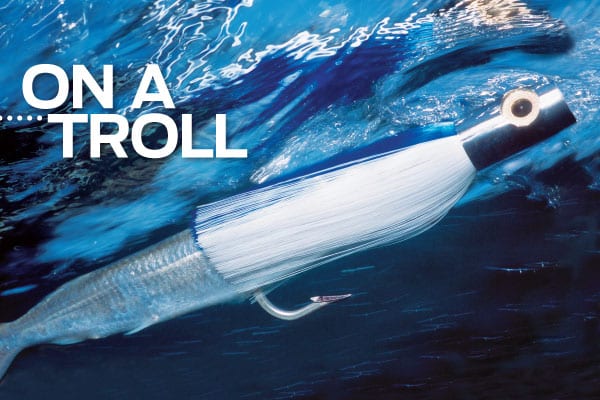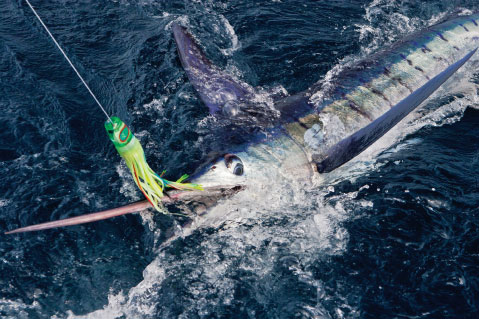
On A Troll
In the world of offshore saltwater fishing, trolling ranks as one of the most preparation?intensive methods anglers can tackle. From choosing components such as lures, leader and hooks to debating crimp versus knot connections, captains drill down to the essential details that determine the success of the day. To offer some suggestions for targeting four of the most popular offshore species — marlin, sailfish, dolphin and tuna — I contacted top charter and tournament captains and asked them three basic questions: When and why do you choose to troll for this species? Describe your favorite trolling outfit and rig for this species. Why is this your favorite trolling rig/outfit for this species?

| |Pat Ford|
Marlin
Capt. Gerard “Frothy” de Silva
Hard Play Fishing Charters (Tobago), Pesca Grossa (Madeira)
868-639-7108 (Tobago), 351-962-278-500 (Madeira)
hardplay.net, madeiragrandermarlin.com
When and why do you choose to troll for this species?
The marlin season off Tobago, in the Caribbean, runs from February through May. In Madeira, Portugal, the biggest marlin are caught mid-May through mid-September.
We mostly troll a combination of lures and lures with bait. In Madeira and the Caribbean, that works best as we are mostly searching for fish in a large area. On a rare occasion, we use live bait when we find a good concentration of fish in a small area like a seamount or an edge.
Describe your favorite trolling outfit and rig for this species.
My rig of choice is an Iland Lures Sea Star in blue and white with the flash (Mylar) strips on it. This rig comes to life when it is combined with a bait such as ballyhoo or my bait of choice — the flying fish. The flying fish is much tougher and can be trolled all day long at 8 knots.

| |Illustrations by David Shepherd|
I rig the Sea Star on a 28-foot length of 400 Momoi X-hard mono with a single-hook pin rig. I like the Jobu 10/0 hook when we use bait, as the wider gap allows for a better hookup.
It’s important that the hook exits the anal vent on the bait because it swims better that way, and the hookup rate is better if the hook comes out as far back in the bait as possible without making a cut. If rigged right, there should be no cut at all where the hook exits.
The pin rig is a short piece of the same 400-pound hard mono about ¾-inch long, bent upward at 90 degrees behind the second crimp. The bait spring is used to attach the pin to the flying fish. It’s very important to tie the bait with waxed twine after screwing down the spring. I usually pass a bit of waxed twine through the bottom of the eye socket and tie it tightly under the gill plate with a few overhand knots. That keeps the bait from being pulled off on the strike.
In the Caribbean, I use this mostly on 80-pound outfits: curved-butt trolling rods with Penn Internationals. I crimp the 28-foot leader to a snap swivel, which is attached to the main line from a 5-foot Bimini twist with a cat’s paw knot. I sometimes use the same setup on 50-pound tackle with a 300-pound leader. In Madeira, I use it on 130-pound tackle with 520-pound leader.
Why is this your favorite trolling rig/outfit for this species?
The great thing about the Sea Star/flying-fish combo is that it works for all sizes of marlin and many other offshore game fish. I’ve caught marlin from 50 to 750 pounds and have hooked bigger fish as well. Most anglers will think this might be a bit small for blue marlin. But when it’s combined with a flying fish, it looks much bigger and offers the smell and texture of natural baitfish. I use two of these on my long?rigger lines all the time.
**_

| |Jason Arnold / jasonarnoldphoto.com|
Sailfish
Capt. Glenn Cameron
Flo Rider Fishing Charters (Fort Pierce, Florida)
772-332-1155
fishingftpierce.com
When and why do you choose to troll for this species?
We always troll for sailfish. It’s a tradition thing here (out of Fort Pierce). We train our anglers for competition year-round by trolling for sails. Starting in October, we go up to St. Augustine and New Smyrna Beach, and then we follow the fish down here. By the first week of February, it’s over.
Describe your favorite trolling outfit and rig for this species.
I use a 7/0 Eagle Claw tournament circle hook with a 5-foot leader of 50-pound Momoi fluorocarbon snelled to the hook. I like fluoro because of its higher chafe resistance over mono. To the other end of the leader, I crimp a loop. A 75-pound snap swivel connects the leader to a 10-foot wind?on, which also is 50-pound Momoi fluoro.
I use a fluoro wind-on because of the recoil issue. There’s no stretch in fluoro, so I don’t have to deal with recoil when releasing a fish. It’s safer for mates to grab fluoro than stretchy mono.
The wind-on connects to a short length of doubled 20-pound Momoi high-vis mono main line with an Albright special. High-vis lets me see where the fish is going, which is important since we typically have more than one fish on at a time.
| David Shepherd |
The bait is a small ballyhoo with a ?-ounce sinker under its chin. I attach the bait with 15-pound Monel wire to a No. 10 barrel swivel that goes over the point of the hook. I remove the pectoral fins during the rigging process and run the Monel down through both lips, hook on the sinker, then go around the gills and back through the eye sockets, and cut off the beak.
I cut a slot in the anal slit of the ’hoo large enough to remove the air bladder and guts, then gently pop its back so the bait is limber.
I fish this with a Daiwa Saltiga 20 lever drag and a Blackfin 12-20 rod. Its parabolic action bends all the way through to the foregrip — you need something with a lot of give so you don’t pull the hook.
Why is this your favorite trolling rig/outfit for this species?
This rig is my favorite because it’s very simple, and the simpler you keep your rig, the better off you are. We do use a skirt sometimes, but under protest. If the fish get finicky, we will add color.
Dolphin

| |Chris Woodward|
Capt. Rom Whitaker
Release (Hatteras, North Carolina)
252-986-1031
hatterasrelease.com
When and why do you choose to troll for this species?
Big dolphin start to show around mid- to late April and stay through May, tapering off in June. We have excellent dolphin fishing all summer, but the later fish are mostly bailers (3 to 6 pounds) with a few gaffers.
I choose to troll because you can cover a lot of ground in the course of a seven-hour fishing day. At that time of year, we usually have some distinct current edges or grass lines, depending on the Gulf Stream and its eddies. A lot of boats stop on the first grass line they see and fish there all day. I personally don’t like fishing behind a bunch of boats, so I usually keep going or just set out in the open over 50 fathoms and start looking for something floating. Many days, you can find a second or third grass line in deeper water.
Describe your favorite trolling outfit and rig for this species.
My favorite rig is a 4-inch Mold Craft Junior Wide Range in pink and blue over a strip bait (menhaden, false albacore or Uncle Josh offshore pork rind). The strip is about eight inches long and about an inch wide, squared at the front and tapered to the end.
I use two Mustad 3407SS 7/0 hooks rigged together, tied to 25 feet of 125-pound clear Sufix mono with a clinch knot. I crimp a loop at the end of the leader and attach it to a 100-pound-test Kroc ball-bearing snap swivel. Above the swivel, I use light-blue Berkley ProSpec mono main line. I double about two feet of the main line, using a Bimini twist, and tie that to the swivel with a uni-knot.
I’ll run this rig with a Penn International 30 and matching IGFA Penn rod. I also use standard ballyhoo rigs on 80-pound leader to 30-pound mono on a Penn Squall 50LD with a 6½-foot medium-action rod.
Why is this your favorite trolling rig/outfit for this species?
The rig’s my favorite because we might encounter 10-pound or 50-pound dolphin. This rig catches most of them most of the time. Smaller dolphin will pick the bait off a single hook. The strip bait works as good as any other bait, and it’s a lot less expensive.
Yellowfin Tuna

| |Jim Rizzuto|
Capt. Dennis Cintas
Tropical Sun Sportfishing (Kona, Hawaii)
808-960-5900
alohakonafishing.com
When and why do you choose to troll for this species?
We troll for yellowfin tuna all year. Our pods of spotted dolphin attract tuna in quantities that vary during the year. However, from June through September, yellowfin migrate to our waters to spawn. We troll in a similar fashion, but we focus on water depths from 500 to 1,000 fathoms off the island of Hawaii. When the ocean currents push in toward the island, we troll in 100 to 500 fathoms, looking for signs of tuna and the presence of bait.
Describe your favorite trolling outfit and rig for this species.
My favorite tuna rig is a 20- to 25-foot section of 220-pound Momoi fluorocarbon crimped to a 7-inch Koya or Joe Yee resin bullethead in either light-blue or mother-of-pearl color with a Flashabou skirt and Mylar wings. Flashabou, which was originally used as a fly-tying material, has revolutionized lure development for yellowfin tuna and blue marlin more than any other innovation I’ve seen in 25 years.
Beneath the lure is a single Mustad 9/0 Southern and Tuna hookcrimped to the leader. Ahead of it is a string of rigging beads.
The top of the leader is crimped into a loop and attached to the 130-pound-test Amilan mono main line with a Sampo HD double-ring snap swivel. The main line is crimped to the snap swivel.
My preferred rod is a 6 ½-foot, 130-pound Seeker blank with roller guides. I like the Shimano Tiagra 130 two-speed reel.
Why is this your favorite trolling rig/outfit for this species?

| |Jim Rizzuto|
Most every charter captain and recreational angler is running one of these Flashabou-skirted lures and enjoying phenomenal success. In my opinion, all the credit goes to my longtime friend and successful charter-boat captain Jay Lighty. This skirt material attached to a straight-running jet head is, in my professional opinion, the absolute best trolled-lure combination for yellowfin tuna today.
All captains I talked with mentioned other bait options and other setups, based on conditions and timing. However, when cornered about which one rig to highlight, their choices jelled quickly.
_Will these baits always produce? That’s questionable, but that’s also fishing. _
Photos by (First to Last) Capt. Tim Simos/ BluewaterImages.net, Pat Ford, Jason Arnold / JasonArnoldphoto.com, Chris Woodward, Jim Rizzuto
Illustrations by David Sheppard
_**








